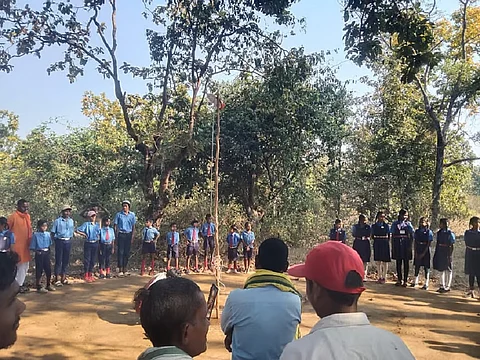

In Kamepur village, Chhattisgarh, the Community Forest Resource Rights (CFRR) have transformed the tribal community's relationship with the forest, granting them true independence.
With rights over forest produce and management, the villagers celebrate their freedom by hoisting the tricolour in the forest, marking a significant shift in their economic and social empowerment.
This is the third of a 3-part series. Read the first and second part
For Chhattisgarh’s tribal community, the Community Forest Resource Rights (CFRR) obtained under the Forest Rights Act is real freedom. This can be understood from the example of Kamepur village. The forest is the lifeline of the residents here.
Udayram Netam, chairman of the forest resource management committee (FRMC) of Kamepur village, which is included in the buffer zone of Udanti-Sitanadi Tiger Reserve, said the village had been granted Community Forest Resources (CFR) over 2,366 hectares of forest in 2015. But it was changed to CFRR in 2021 and the area was also increased to 3,304 hectares. Under CFR, the villagers had rights only on fodder, not on forest produce and forest management. Once they were granted CFRR, they got these rights as well, which was actual independence for them, he added.
The residents of Kamepur hoist the tricolour in the forest on every Republic Day and Independence Day after getting the right over forest produce from CFRR, according to Netam. This is because the right means a lot to them.
They get some forest produce or the other throughout the year, such as Patal Kumbhda, Bhilwa, Mahua, Tendu fruit, Tendu leaves, Char, Sal seeds, wild mushroom, Bhui Neem, Amla, Bibinding and Mahul leaves. These strengthen the livelihood of the residents. Income from forest produce is the main reason for zero migration from the village.
Rameshwar Kapil, secretary of Kamepur’s FRMC, said the cutting of wood in the forest has completely stopped at the moment. He added that the committee has not even given permission to the forest department to cut trees, due to which the forest department is angry with them.
According to Kapil, 60-70 per cent of the residents’ income comes from forest produce and the remainder from agriculture. He said CFRR has given economic independence to the people of Kamepur and that is why the freedom of the forest is a lifeline for them.
A report titled Potential for Recognition of Community Forest Resource Rights under India’s Forest Rights Act, published in July 2015 by the Rights and Resources Initiative, found that at least 4 crore (40 million) hectares of forest land across India is eligible for CFRR.
According to the report, at least 15 crore (150 million) people (including about 90 million tribals) live in communities that will benefit from CFRR. There are 120 such districts in the country, mostly located in the tribal areas of central India. More than 40 per cent of the population in these districts lives in villages that have forest land. The report also says that at least a quarter (170,000) of India’s villages are eligible for CFRR.
According to the report, the government can unleash the creative potential of tribals by bringing 40 million hectares of forest land under the jurisdiction of Gram Sabhas, which will promote ecological restoration, community conservation, livelihood generation and development in forest areas.
Benipuri Goswami, secretary of Khoj, a non-profit organisation that has been playing a key role in helping the tribal community in Gariaband district avail CFRR, told Down to Earth that individual forest rights and community forest rights grant user powers, while CFRR grants the responsibility of management, conservation and regeneration.
The forest department sees forests from the point of view of timber, while the community sees forests from the point of view of livelihood and NTFP (non-timber forest produce).
“This is the reason why there is better management of forest fires in villages with CFRR. Many Gram Sabhas did not allow forest fires to occur in their villages for many years, due to which new forest produce flourished and strengthened the livelihood of the villagers,” said Goswami.
Gariaband’s divisional forest officer Laxman Singh also believes that conservation of forests is necessary. And when conservation takes place, everything starts growing on its own. He added that to maintain continuity on forest produce, this right is obtained only when the Gram Sabha assures management.
Any right under forest rights, whether it is individual, community or CFRR, is not easily available, said Goswami. It is even more difficult in the core villages of the Udanti-Sitanadi Tiger Reserve. “In Kamepur village, there is still tension between the FRMC and the forest department because they did not allow the forest department to cut wood from the forest.”
“The forest department considers us its enemy because a large part of the forest has gone out of their hands under CFRR,” claimed Kapil.
(This story has been published under the Promise of Commons Media Fellowship 2024)